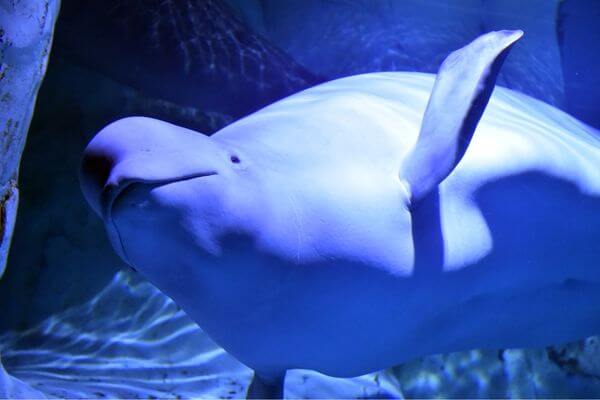In the icy seas of the Arctic, there is a magical and fascinating creature that enchants the hearts of all who know it: the Beluga Whale. Also called the “Canary of the Arctic Seas”, this species is known for its captivating appearance and sociable behavior. In this article, we’ll explore in detail its unique characteristics, its essential role in the Arctic ecosystem and the challenges it faces in an ever-changing world.

An Enchanting View of the Beluga Whale
The Beluga Whale has a striking appearance, with its white skin and rounded head. This unique coloration is a result of adaptation to the arctic environment and helps camouflage among sea ice. In addition, its robust body is covered with a thick layer of fat, which acts as a thermal insulator in the icy waters.
With an average length of 4 to 5 meters and a weight that can reach 1.5 tons, Beluga Whales are considered medium-sized compared to other whale species. Their eyes are small, but their fins are relatively large and rounded, allowing them to move easily in arctic waters. These physical adaptations are essential for the survival and reproductive success of these whales in this challenging environment.
Sociable Behavior and Melodic Communication
One of the most endearing characteristics of the Beluga Whale is its sociable behavior and group interactions. They are known to form family “pods”, which can gather dozens or even hundreds of individuals. This close sociability plays an important role in protecting against predators and foraging for food.
Beluga Whale pods are made up of members of different ages and genders. These social groups allow for the sharing of information about feeding sites, migrations and potential dangers. In addition, Beluga Whales demonstrate cooperative behavior, helping each other in hunting and raising their young.
In addition, they have a unique vocal communication system. Their sounds range from high-pitched whistles to melodic trills, which echo across the arctic ocean. These vocalizations play a vital role in intraspecific communication, helping to locate food and guide them during migrations. These complex and varied sounds are produced through an organ called “melon”, located in the head of the Beluga Whale.
The Key Role of the Beluga Whale in the Arctic Ecosystem
This species plays a key role in maintaining the ecological balance in the Arctic. As opportunistic predators, they feed mainly on fish, squid and crustaceans, controlling populations of these species and contributing to the health of the marine ecosystem.
By regulating prey populations, Beluga Whales help maintain balance in food chains. This prevents the overpopulation of certain species and the imbalance of marine ecosystems. Furthermore, Beluga Whales play an important role in nutrient cycling. During feeding, they consume large amounts of prey, releasing essential nutrients in the form of droppings, which enrich Arctic waters.
Challenges and Threats for the Beluga Whale
Sadly, Beluga Whales face increasing challenges in their natural habitat. Climate change and melting sea ice directly affect their access to feeding and breeding areas. Declining sea ice could also expose beluga whales to predators such as polar bears, increasing risks to the species.
Noise pollution caused by maritime traffic and human activities also poses a significant threat to these whales. Undersea noise interferes with their communication skills and finding food, as well as causing stress and discomfort. This can lead to reproduction problems, reduced reproductive success rates, and even abandonment of feeding and breeding areas.
Illegal hunting and capture for the entertainment industry also poses significant threats to the Beluga Whale. Although commercial hunting has been banned in many countries, illegal activities still occur in some regions. In addition, the capture of Beluga Whales for display in water parks has been a controversial practice, with negative impacts on the health and well-being of these animals.
Necessary Conservation Actions
In Conclusion the Beluga Whale is a treasure of the Arctic seas, with its charming appearance, sociable behavior and melodic communication. This species plays an essential role in the marine ecosystem, regulating prey populations and enriching Arctic waters with vital nutrients.
However, it faces significant challenges due to climate change, pollution and human activities. Protecting and preserving their habitat is essential to ensure their survival and maintain the health of Arctic seas.
As a society, we must work together to reduce threats and promote their conservation. That includes:
- The reduction of greenhouse gas emissions;
- The control of noise pollution in sensitive areas;
- The implementation of policies for the protection and sustainable management of populations of Beluga Whales;
- The creation of protected marine areas;
- Promoting regulations to control illegal hunting and capture for commercial purposes;
- It is crucial to invest in scientific research to better understand the needs and behavior patterns of these whales in order to develop effective conservation strategies.
- Another important aspect is to increase public awareness and education about the importance of Beluga Whale conservation and Arctic ecosystems as a whole. It is necessary to inform people about the challenges these whales face and how everyone can contribute to their protection, whether through sustainable choices, support for conservation organizations or involvement in awareness activities.
In addition, it is essential to promote international cooperation for the conservation of Beluga Whales. Arctic countries and the global community must join forces to address common challenges and adopt policies and agreements that effectively protect these species and their habitats.
By protecting the Beluga Whale, we are preserving a symbol of the beauty and biodiversity of the Arctic seas. These magnificent creatures play a vital role in the ecological balance and health of the oceans. Furthermore, they remind us of the importance of respecting and conserving the diversity of life on our planet.
Ultimately, the survival of the Beluga Whale is in our hands. We have a responsibility to act now to ensure these enchanting creatures can continue to swim in their natural habitats, inspiring us and reminding us of the wonder of nature. Protecting the Beluga Whale is a call to action and a commitment to preserving the beauty and diversity of the Arctic seas for present and future generations.

